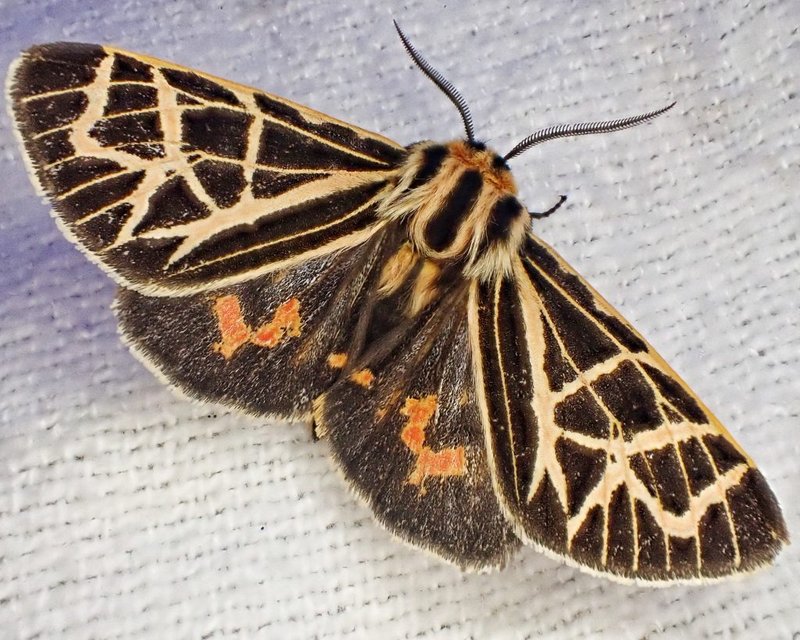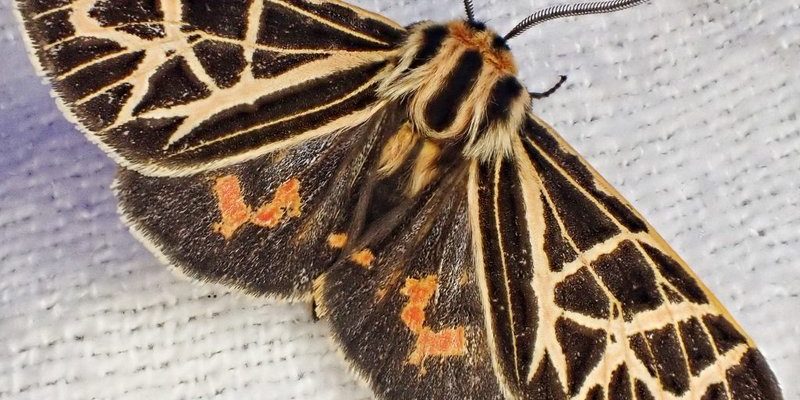
The Tiger Moth is one of nature’s most fascinating winged creatures. With its striking patterns and vibrant colors, this moth stands out in the world of insects. Imagine a small canvas painted with bold stripes and soft spots, fluttering about on summer nights. They belong to the family Arctiidae and are known for their beautiful, often hairy bodies, which can give them a fuzzy appearance. If you’ve ever seen one, you might have thought, “Is that a butterfly or a moth?” That’s a common question, and understanding these little beings can enhance our appreciation for them.
Tiger moths are not only beautiful; they also play essential roles in ecosystems. They act as pollinators and serve as food for various predators. Their unique colors can even help them defend against threats by deterring birds and other animals that recognize their patterns as indicators of toxicity. So, while they may just seem like pretty insects, they have fascinating lives that are more complex than they appear at first glance.
In this article, we’ll dive into the world of Tiger Moths, exploring their characteristics, behavior, and role in the environment. From their habitat preferences to their lifecycle, we’ll unravel the mysteries surrounding these incredible creatures.
Physical Characteristics
The physical traits of Tiger Moths make them easy to recognize. They typically have bright, contrasting colors, usually featuring orange, black, or yellow. This vibrant appearance can vary widely among species, with some having intricate patterns of spots and stripes. This coloration not only makes them beautiful but also plays a crucial role in their survival, as discussed earlier.
One interesting aspect of tiger moths is their size. Most adult tiger moths measure between 1.5 to 3 inches across their wingspan. Some species can be larger, though, leading to a wide range of variability in appearance. The moths’ bodies can be hairy, contributing to their fuzzy looks, which is both an attractive trait and a defense mechanism, as these hairs can irritate predators.
Another notable feature is their unique wing structure. Tiger moths often have a thicker forewing that overlaps the hind wing when at rest, resembling a little umbrella. This adaptation helps them blend into their surroundings, making it harder for predators to spot them. Being aware of these details helps us appreciate the extraordinary design of nature in these seemingly simple creatures.
Behavior and Habitat
Tiger moths are primarily nocturnal, meaning they come alive when the sun goes down. They are attracted to light, which is why you might find them fluttering around porch lights or street lamps. This behavior not only aids in their nighttime activities but also puts them at risk of becoming prey for hungry birds and other predators.
When it comes to habitat, Tiger Moths are quite versatile. They are commonly found in gardens, forests, fields, and meadows almost all over the world, primarily in temperate regions. Some species prefer certain types of environments, like open fields or wooded areas, while others thrive in urban settings. This adaptability is one reason tiger moths are prevalent in various climates.
To thrive, they need a good supply of host plants, as their larvae (caterpillars) feed on leaves from various trees, shrubs, and herbaceous plants. In turn, these plants not only provide food but also a secure place for the caterpillars to hide from predators. Understanding their behavior and habitat helps us see how interconnected the natural world is.
The Lifecycle of a Tiger Moth
The lifecycle of a Tiger Moth is truly captivating. Like all moths, they undergo a complete metamorphosis, which includes four stages: egg, larva (caterpillar), pupa (chrysalis), and adult. The cycle begins when a female lays her eggs on the leaves of suitable host plants in late spring or early summer. Depending on the species and environmental conditions, these eggs may hatch within a week to a month.
Once hatched, the caterpillars emerge and start munching on the leaves around them. This feeding phase is crucial, as they need to grow and store energy for their next stage. During this period, caterpillars may have bright colors or bold patterns, serving as a warning to potential predators that they might be toxic or unpalatable. The larval stage can last several weeks to a few months, depending on the specific species and environmental factors.
When the caterpillars are ready, they enter the pupal stage. They spin a protective case around themselves, often called a chrysalis, where they undergo remarkable transformations. After about two weeks to several months, depending on various factors like temperature, they emerge as adult tiger moths, ready to begin the cycle anew. This fascinating journey of transformation highlights the complexity and beauty of their life cycle.
Diet and Feeding Habits
As caterpillars, Tiger Moths are primarily herbivores, feeding on a variety of leaves from different plants. They mostly prefer broadleaf plants and can adapt their diet based on availability. This flexibility in their feeding habits helps them thrive in various environments. The young caterpillars may even feed in groups, which provides some safety in numbers against predators.
Once they metamorphose into adults, their diet changes. Adult tiger moths primarily feed on nectar from flowers. This is where they contribute to the ecosystem as pollinators. Their fluffy bodies pick up pollen while they sip nectar, helping plants reproduce and continue the cycle of life. You might find them hovering around blooming flowers on warm summer evenings, adding to the beauty of the garden or meadow.
Interestingly, some adult tiger moths have developed unique adaptations related to their feeding habits. For instance, certain species can produce sounds by rubbing their wings together—a behavior known as stridulation. This sound can serve various purposes, including attracting mates or scaring off potential predators. Overall, they play a significant role in maintaining healthy ecosystems through their feeding habits.
Conservation Status
Many tiger moth species are currently stable, but some are facing threats due to habitat loss and climate change. Urban expansion, agricultural practices, and pesticide use can disrupt their natural habitats, affecting their populations. Monitoring and research efforts are ongoing to address these issues and help protect these beautiful creatures.
Local conservation groups often encourage practices that support tiger moth populations. Planting native plants and reducing pesticide use can make a big difference in creating a welcoming environment for them. It’s fascinating to think that your gardening choices can impact these moths in such a way!
As we learn more about tiger moths and their ecological role, it’s essential to advocate for their protection and preserve their habitats. Every little effort counts in ensuring that future generations can enjoy the wonder of these incredible insects.
Interesting Facts About Tiger Moths
Tiger Moths have captivated the interest of many due to their unique characteristics and behavior. Here are a few entertaining tidbits: they are often mistaken for butterflies because of their bright colors, but they belong to the moth family. In fact, some species can be so brightly colored that they are often referred to as “day-flying moths,” as they are commonly seen during the day, unlike most moths.
One particularly intriguing fact is that some tiger moths can produce their own sounds. These sounds, created by rubbing their wings together, can deter predators or attract mates. This means they have a sort of “musical” language to communicate with one another—how cool is that?
Another interesting aspect is their role in various cultural narratives. In some cultures, tiger moths symbolize transformation and metamorphosis due to their incredible life cycle. They serve as a reminder of the beauty that emerges from change, inspiring many to appreciate life’s transformative moments.
FAQ
How can I attract Tiger Moths to my garden?
If you want to attract tiger moths to your garden, consider planting native wildflowers and reducing lawn areas. Providing a variety of flowering plants ensures a steady supply of nectar. Additionally, leaving some areas a bit wild, with taller grasses and native shrubs, can create a suitable habitat for their caterpillars.
Are Tiger Moths harmful to humans?
No, tiger moths are generally not harmful to humans. While some species may have hair that could irritate skin upon contact, they do not sting or bite like bees or wasps. They are quite harmless and are more of a marvel to observe than a threat.
What do Tiger Moth larvae look like?
Tiger moth larvae, also known as caterpillars, can be pretty striking! They often have bright colors and unique patterns that can vary by species. Many are fuzzy and can even be covered in long hairs, which serve as a protective mechanism against predators.
Do Tiger Moths play any role in the ecosystem?
Yes! Tiger moths are important pollinators. As they feed on nectar from flowers, they transfer pollen, helping plants reproduce. Additionally, their larvae are a food source for various birds and other predators, making them an integral part of the food web.
What is the lifespan of a Tiger Moth?
The lifespan of a tiger moth can vary by species, but generally, adults live for several weeks to a few months. The complete lifecycle, from egg to adult, can take several months to a year, depending on environmental conditions.
Are all Tiger Moths nocturnal?
While most tiger moths are nocturnal, some species are known to be diurnal, meaning they are active during the day. These day-flying tiger moths can often be seen flitting among flowers and may be mistaken for butterflies.
How can I protect Tiger Moths in my area?
To help protect tiger moths, you can create a butterfly-friendly garden by planting native species, avoiding pesticides, and providing diverse habitats. Participating in local wildlife conservation efforts can also make a significant impact on their populations.
What do Tiger Moths eat as adults?
As adults, tiger moths primarily feed on nectar from flowers. This diet not only sustains them but also allows them to play a vital role as pollinators in many ecosystems. They are often attracted to brightly colored blooms.
How many species of Tiger Moths are there?
There are over 11,000 species of tiger moths worldwide, with many found in North America alone. This diversity showcases the adaptability and beauty of the moths within this family. Each species has its unique characteristics and habitat preferences.
Why are Tiger Moths important in culture?
Tiger moths often symbolize transformation and change in various cultures. Their remarkable lifecycle serves as an inspiration for many, reminding us of nature’s beauty and resilience. They are sometimes featured in folklore and stories that celebrate the journey of growth and metamorphosis.
Can Tiger Moths survive in urban areas?
Yes, many tiger moth species can adapt to urban environments. They often find food and habitat among gardens, parks, and open spaces. By creating butterfly-friendly areas in cities, we can help support their populations.

